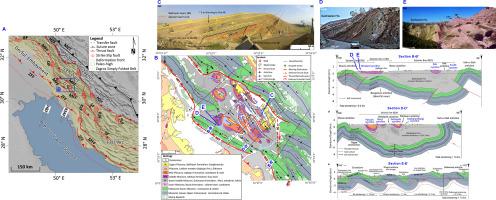Tectonophysics ( IF 2.7 ) Pub Date : 2021-02-24 , DOI: 10.1016/j.tecto.2021.228791 K. Heydarzadeh , H. Hajialibeigi , J. Vergés , G.R. Gharabeigli

|
This paper deals with the tectono-sedimentary evolution of the Dehdasht Basin, located at the boundary between the Izeh Zone and the Dezful Embayment, in the Central Zagros. The structural evolution of the basin is closely related to the coeval sedimentation of Neogene Fars Group foreland basin deposits. The analysis of five geological cross-sections reveals the interaction between tectonics, Gachsaran Formation diapirism and coeval sedimentation as well as the influence of hidden basement-involved faults. The great thickness of the Miocene Gachsaran evaporites contributes to the internal structure of the Dehdasht Basin as well as decouples the Competent Group structure at depth from the Passive Group structure cropping out at surface. The basin forms a synclinorium limited by high amplitude NW-SE trending anticlines filled with Neogene deposits. Its internal structure is characterized by relatively thin growth synclines-minibasins separated by Gachsaran diapiric ridges formed under a combination of shortening and diapirism. The amount of shortening across the basin ranges between 7.5 and 13.1 km (16–24%) whereas the restored preserved thickness of Gachsaran evaporites increases southeastwards from 2 to 2.85 km. This high thickness is interpreted as partly accumulated by gravity gliding from the rising surrounding anticlines. Observed changes in structural relief across and along the Dehdasht Basin suggests its development above an array of hidden and linked basement faults including segments of the Mountain Frontal Flexure with NW-SE Zagros trend under the northern and southern boundary anticlines and a transfer fault with N-S Arabian trends at the SE border. The observed structural variations both along-strike and across the Dehdasht Basin at a local scale are similar to those already found at larger scales along the major Kazerun Fault Zone.
中文翻译:

Dehdasht构造盆地的构造-沉积演化(伊朗中部扎格罗斯)
本文研究了位于扎格罗斯中部伊泽(Izeh)区与Dezful Embayment(边界)之间边界的Dehdasht盆地的构造-沉积演化。盆地的结构演化与新近纪法尔斯群前陆盆地沉积的同期沉积密切相关。通过对五个地质断面的分析,揭示了构造学,Gachsaran地层成岩作用和同期沉积作用之间的相互作用,以及隐伏的基底相关断层的影响。中新世Gachsaran蒸发岩的厚度很大,这有助于Dehdasht盆地的内部结构,并且使深部的主管组结构与从地表露出的被动组结构脱钩。该盆地形成了一个由充满新近纪沉积物的高振幅NW-SE趋势背斜限制的斜斜层。它的内部结构的特征是生长稀薄的斜向小盆地,被缩短期和成年期的组合形成的Gachsaran diapiric脊分隔开。整个盆地的缩短量在7.5和13.1 km之间(16–24%),而恢复的Gachsaran蒸发岩保留厚度从2 km向东南增加到2.85 km。如此高的厚度被解释为部分是由于重力从上升的周围背斜滑行而累积的。观察到的整个Dehdasht盆地的构造起伏变化表明其在一系列隐蔽和链接的基底断层之上发育,包括在北部和南部边界背斜下的具有NW-SE Zagros趋势的山前弯曲带段和与NS Araban的转移断层SE边界的趋势。









































 京公网安备 11010802027423号
京公网安备 11010802027423号